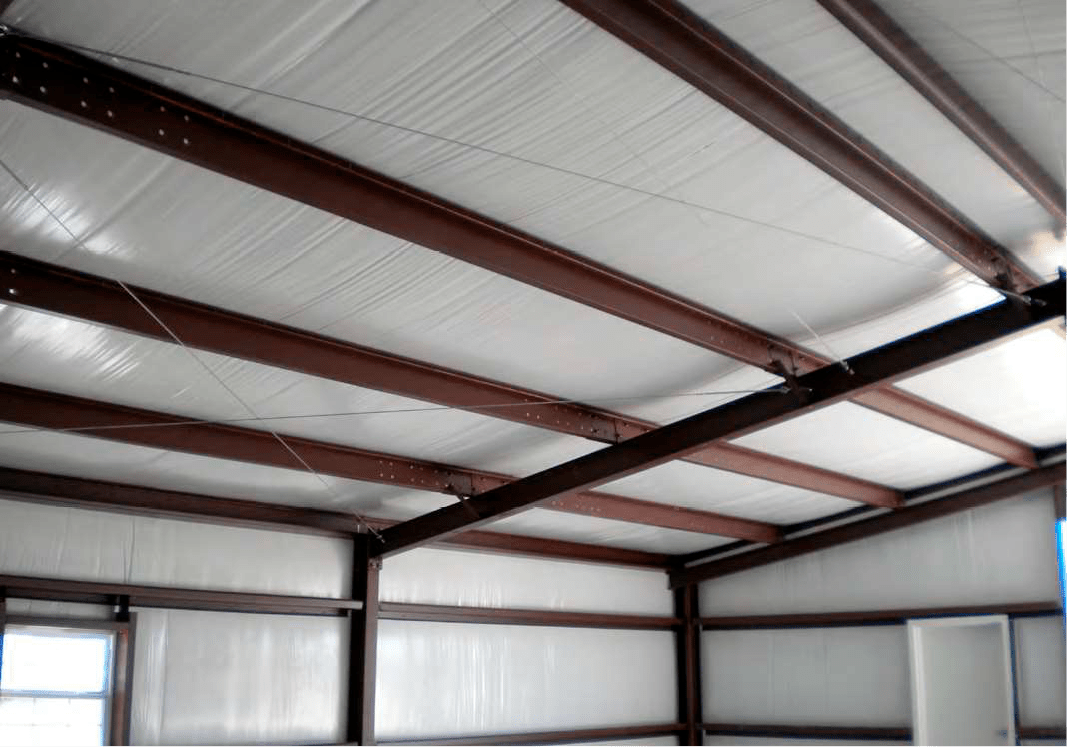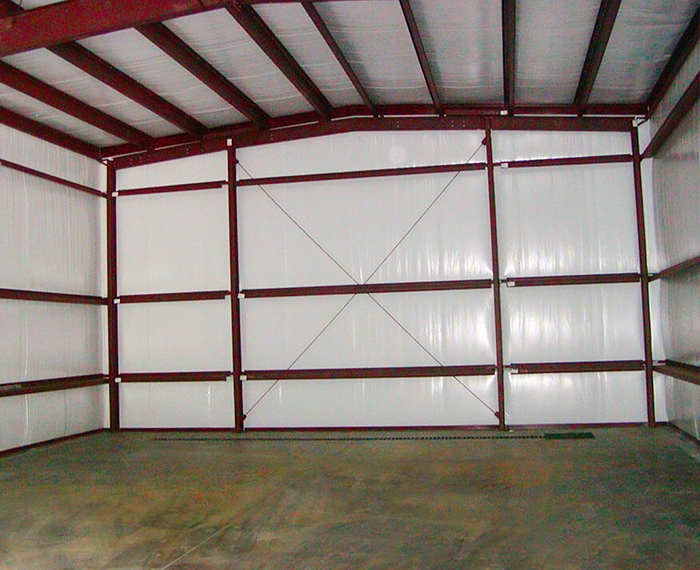Scroll down to use the Fiberglass Insulation Wholesale Calculator to determine actual cost.
Ordering Vinyl-faced insulation at wholesale is easy:
✅ Calculate your wholesale price with the calculator.
✅ Click the preferred “Buy Now” button.
✅ Fill out the Order Form and pay the related brokerage fee
✅ Expect a call from shipping within 2 days. Insulation delivers in as little as 7 days!
Basic Differences between Vinyl-faced insulation and Vinyl-backed insulation

- Vinyl-faced Insulation: This insulation is usually made of fiberglass or mineral wool. It has a vinyl sheet attached to one side. The popular facings are VR-R (plus), WMP-10, WMP-30, and WMP-50. The vinyl facing acts as a vapor barrier, protecting the insulation from moisture, which can damage the building members and content. The vinyl-faced is pointed to the interior of the structure. If you have seen insulation in a metal building, you were most likely looking at vinyl-faced insulation.
- Vinyl-backed Insulation: Similar to vinyl-faced insulation, it consists of fiberglass or mineral wool. However, the vinyl backing is attached to the opposite side (rear side) side of the insulation. This backing serves as a protective layer rather. It is not a primary vapor barrier.
How about Thermal Performances?
- Whether you have vinyl-faced or vinyl-backed insulations, they will provide a good thermal performance if the materials and thicknesses are the same. Fiberglass will have a different thermal resistance than mineral wool.
Condensation – Moisture Resistance
- Vinyl-faced Insulation: Here is where there is a difference. The vinyl face effectively acts as a moisture barrier; therefore, it is more suitable for areas with dampness. Remember, the key to insulation is maintaining the R-value and then preventing condensation with causes mold growth.
- Vinyl-backed Insulation: With this type of insulation, it offers very little protection against moisture. It is more for additional support. It is not a primary vapor barrier.
Which one is easier to Install?
- Vinyl-faced Insulation: This fiberglass or mineral wool insulation is fairly easy to install. It is usually rolled over the purlins and girts and pinned down by the sheeting.
- Vinyl-backed Insulation: This installation is applied the same; however, because it doesn’t act as a strong vapor barrier, an extra installation step may be needed such as adding a separate vapor barrier.
Reliability and Durability
- Both insulation types are reliable and durable. Factory Steel Overstock offers a VRR+ facing that is designed to be resistant to tearing and puncture due to the additional strength of the vinyl layer. However, not all fiberglass insulation is made the same.
Costing
- The cost difference will primarily be based on the quality of the insulation material and the thickness of the vinyl. As a rule of thumb, vinyl-faced insulation is usually a little more expensive due to its acts as both insulation and a vapor barrier.
Common Usages
- Vinyl-faced Insulation: This insulation is perfect for areas where a moisture protector and thermal efficiency are required. It is often used in basements and crawl spaces. Though we at Factory Steel Overstock feel our High R-value reflective insulation is the best choice for high humidity areas, many customers still choose this time insulation.
- Vinyl-backed Insulation: People place this insulation on interior walls or ceilings where additional moisture protection is not important.
Summation: Both vinyl-faced and vinyl-backed insulation rolls for steel buildings are generally good thermal protectors, but there is a substantial difference in their condensation protection. Therefore, one will need more of an additional vapor barrier.
Price vinyl-faced insulation protective facings
Review the prices of four vapor-barrier and tear resistant facings (VR-R Plus, WMP-10, WMP-30, and WMP-50) listed within the Fiberglass Insulation Wholesale Calculator. The prices are the actual costs to Factory Steel Overstock. The public pays a low brokerage fee to purchase at these rates. Deliveries are as quickly as 7 days. For questions, call 1-888-512-1116
WMP-VR-R Plus- Most Popular!
YOU CAN ORDER AT THESE PRICES IN LESS THAN 3 MINUTES! YOU CAN HAVE YOUR INSULATION IN AS QUICKLY AS 7 DAYS!
Four Vinyl-faced insulation options
WMP VR-R (PLUS):

Our VR-R Plus vinyl-faced insulation is your trusty sidekick when it comes to vapor retarders! It’s the go-to choice for metal building insulation, featuring a sleek white polypropylene film, a strong tridirectionally fiberglass scrim, and a shiny metallized polyester layer. This durable, moisture-resistant superhero keeps things secure and dry—because even buildings need a little protection from the elements!
WMP-10:

This vinyl-faced insulation is the all-star of vapor retarders, bringing versatility and reliability to your metal building insulation projects! With its stylish white metallized polypropylene film, flame-resistant adhesive, and a tough tri-directional fiberglass/polyester scrim laminated to natural kraft paper, it’s built to handle whatever you throw at it. Offering the perfect mix of strength and moisture resistance, WMP-10 is your go-to sidekick for top-notch insulation!
WMP-30

The WMP-10 vinyl-faced insulation is the heavyweight champion of vapor retarders, tailor-made for metal building insulation! With its tough white polypropylene exterior, sturdy natural kraft paper backing, and reinforced tri-directional fiberglass and polyester scrim, this bad boy is built to last. It’s got strength, durability, and moisture resistance in spades—basically, it’s the superhero your insulation needs to stay strong and dry!
WMP-50

Our WMP-50 vinyl-faced insulation is the powerhouse of vapor retarders, built for the toughest metal building insulation jobs! With its tough white polypropylene film, flame-resistant adhesive, and tri-directional fiberglass/polyester scrim laminated to a shiny metallized polyester film, it’s ready to tackle any challenge. This heavy-duty champ brings top-notch moisture control and long-lasting durability, making it the perfect partner for all your demanding insulation projects!
Here’s a breakdown of the differences between fiberglass and mineral wool insulation:
Fiberglass Insulation
Ease of installation: Lightweight and easy to cut, but itches if you touch it without gloves.
Made from: Spun glass fibers, often from recycled glass.
Form: Available in batts, rolls, or loose-fill.
R-Value (thermal resistance): Around R-2.9 to R-3.8 per inch for standard batts; high-density versions can go up to ~R-4.3.
Fire resistance: Naturally fire-resistant, but can melt at very high temps (~1,000°F).
Soundproofing: Good, but not as good as mineral wool.
Moisture resistance: Not great. Can absorb water and lose performance.
Price: Cheaper than mineral wool.
Mineral Wool (Rock Wool or Stone Wool)
Ease of installation: Denser and heavier than fiberglass, but still cuttable.
Made from: Spun fibers of natural rock (like basalt) or slag (industrial byproduct).
Form: Comes in batts or rigid boards.
R-Value: Around R-3.7 to R-4.3 per inch.
Fire resistance: Extremely fire-resistant (withstands temps over 2,000°F).
Soundproofing: Excellent—used often in sound studios and between floors.
Moisture resistance: Water-repellent and doesn’t support mold.
Price: More expensive than fiberglass.
“Ordering process, payment, and delivery operated just a described on their website. Received insulation just as ordered and described.” – Brent D
“The process worked just as they said it would and at a price even lower than I was originally quoted….”– Eric Rhodes 1/232/2023





